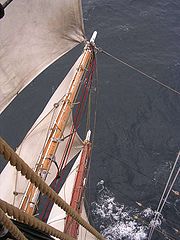
Footrope
Encyclopedia


Formerly, the footrope was the rope sewn along the lower edge of a square sail, and the rope below the yards was called the horse or Flemish horse. These terms will be encountered when reading the classic 18th and 19th century sailing manuals, and may still be used today when referring to older ships.
Although square sails are mostly worked from the deck, in order to be properly stowed (and released from this stowage) they must be folded by hand and tied to the yard with gasket
Gasket (sailing)
In sailing, gaskets are lengths of rope or fabric used to hold a stowed sail in place. In modern use, the term is usually restricted to square-rigged ships, the equivalent items on yachts being referred to by the more prosaic "sail ties"....
s. This requires sailors to go aloft, during which time they stand on the footropes. The ropes are made of either fibre or wire, and are almost always protected from wear by being wormed, parcelled and served
Worm, parcel and serve
To worm, parcel and serve a line is to apply a multi-layered protection against chafe and deterioration. It is a technique not usually used on modern small boats, but is found extensively on traditionally-rigged sailing ships...
, so that the visible outer coating is of tarred thin line. They are attached to the yard via the jackstays or "handrails" to which the sails are also fastened, tied on with many turns of thin line. The inner parts of the footrope are held up towards the yard by vertical lines called stirrups; one of these is visible in the picture on the right. Also visible is the flemish horse
Flemish horse
A flemish horse is a footrope on a square rigged sailing ship that is found at the extreme outer end of the yard. The main footrope runs along the whole length of the yard, but because of its length the angle upwards to where it is attached is quite shallow, and thus it is too high to stand on for...
that the outermost sailor stands on; because this yard is quite small the flemish horse actually extends fairly close to the centre.
Sailors get onto the footropes from the ratlines
Ratlines
Ratlines, pronounced "rattlin's", are lengths of thin line tied between the shrouds of a sailing ship to form a ladder. Found on all square rigged ships, whose crews must go aloft to stow the square sails, they also appear on larger fore-and-aft rigged vessels to aid in repairs aloft or conduct a...
up the mast. Lower down, where everything is bigger, there may be a small length of footrope bridging the gap between ratlines and yard; this is especially necessary on the windward side when the yards are braced hard round, as the gap becomes quite large. Because the yard must be free to move, this footrope is rather loose and hence unstable. Higher up the gap is small enough to step across, though it may be a stretch when hard-braced. Since the footrope will react to the extra weight placed on it, the practice on some ships is to call "stepping on port" (or starboard) before getting on, to warn those already using it.
Once on the yard, modern sailors are able to clip their harnesses onto a safety wire that runs along it (on most ships they will have been unsecured until this point) - in the past, crews enjoyed no such protection. The sailors will now edge out along the footrope until they are spread evenly along the yard. Leaning forwards over the yard helps with balancing on the footrope, but where the buntlines
Clewlines and buntlines
For the revolver, see Colt BuntlineClewlines and buntlines are lines used to handle the sails of a square rigged ship.Although the common perception of a traditionally rigged ship is that the sails are handled from "up in the rigging", the majority of the work is actually carried out from the deck...
come down to the yard it is necessary to lean back or crouch down to get around them. The outermost member of the crew must step off the footrope (calling "stepping off starboard" (or port) if that is the practice) across a small gap onto the flemish horse in order to reach the end of the yard where the clew of the sail is to be hauled up or let go.
Because the footrope provides a rather narrow area to stand on, it can cause sore feet after a while. Modern sailors joining a tall ship are advised to take footwear with a solid sole that will spread the load, rather than the flexible deck shoes and seaboot
Seaboot
Seaboots are a type of waterproof boot designed for use on deck on board boats and ships in bad weather, to keep the legs dry, and to avoid slipping on the wet rolling deck....
s used on yacht
Yacht
A yacht is a recreational boat or ship. The term originated from the Dutch Jacht meaning "hunt". It was originally defined as a light fast sailing vessel used by the Dutch navy to pursue pirates and other transgressors around and into the shallow waters of the Low Countries...
s.

